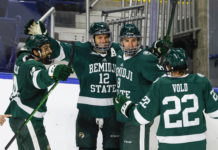There was a pretty good ad campaign from the NHL last season (not sure if it’s still running), throwing out the rhetorical question, “Is this the year?” It was to get you thinking about the possibilities, and the fact that you never know when there’s going to be a record set.
Spinning that line toward Alaska-Anchorage this season, is this the year? Is this the year the Seawolves have a winning record in the second half of the season?
It has been a while. They’ve never done it as a member of the WCHA, in fact. The last time UAA won more games in the second half than it lost was 1991-92, its last season as a Division I independent and also the last time it made the NCAA tournament.
This is of consequence now because the Seawolves are doing pretty well in the first half of the season again. Entering Saturday night’s game at Wisconsin, they’re 7-6-2 overall. Two weeks ago, they beat Colorado College and took the Tigers to overtime before losing.
But there’s always that thought about whether things will continue going as well as they have for the Seawolves in the second half of the season.
Two seasons ago, they were 7-5-2 through 14 games, just like they were this season, before finishing 13-21-3. As such, the Seawolves know better than to take anything for granted.
“It’s like the hardworking farmer who cultivated the land, threw some seeds down and it started to grow,” UAA coach Dave Shyiak said. “But you don’t start making your hay until harvest season.”
Shyiak knows that harvest season for his team is January, February and March. So h’s trying to make sure his team is ready for what appears to be a daunting second half of the season.
After Saturday night’s game at Wisconsin, UAA has four weekends off, then finishes the regular season without a break — 18 straight games. It’s no secret that the Seawolves have more travel to do than just about everyone else in college hockey, and there have been questions as to whether that wears on them as the season gets into the later months.
“We have to be one of the most conditioned teams in the league because of our travel schedule,” Shyiak said.
Of course, no one is crying for the Seawolves.
“I think this job and the Fairbanks job are the toughest jobs in college hockey, because of the location and the leagues we play in,” Shyiak said. “People don’t have to experience the type of obstacles that we go through. But we don’t use that as an excuse. Our kids have dealt with it over the course of the last three years and we’ve been in a lot of games. Now we’re hoping we can get over this hump, especially in the second half.”
